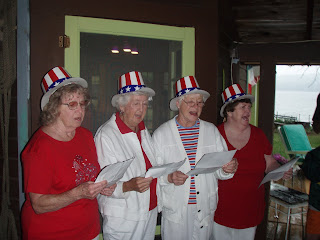Confederation Basin Marina, Kingston Ontario
N 44 13.674 W 76 28.726
Boy is Kingston a nice place. We can vouch for that, at least in summer weather.
Monday morning I got up at first light and we set out for Canada in calm conditions. We have already learned to respect Lake Ontario's reputation as a nasty place to be when it blows hard. As the day went on the wind picked up a little so we got to sail some and motor some. Our intention was to clear customs and to buy charts in Kingston, then perhaps continue on.
As we approached Kingston, the scene was beautiful. We had a meadow covered island to starboard with a big herd of cows munching contentedly. Ahead we could see at least 6 small boat sailboat races in progress. We learned later that this was the International Youth Sailing Championship being held.
We called the downtown Confederation Basin Marina by radio and they assigned us a slip. This is an excellent municipal marina. Very well run and reasonable too. I recommend it to any cruisers who come by. Among it's advantages is that it is in the heart of downtown.
Clearing Canadian customs was easier than I thought. I called 888 CAN-PASS and talked to the customs agent. He asked a series of questions and then said, "OK, your clearance number is 2007
IJKLMN." On the other side, at
Sackets Harbor, they had a video phone hookup to US Customs. You call on the phone and you hold your documents under the camera lens. The camera can't see your face. Evidently, US Customs is all about documents, not people. Neither the US nor the Canadian systems seem to be designed for security and keeping terrorists out. Shame on the US for changing the rules to demand passports at such a non-serious border.
Anyhow, Nick, Libby and I set out on an expedition to find the
Vanderoort Hardware Store to buy charts. It was Nick's first experience in a foreign country so it was a bit of an adventure. Nick was nervous the whole time, fearing that he might meet someone who demanded that he speak French :) We got lost a bit but we had a lovely time strolling up and down Princess Street. Kingston is a very clean and very much alive city. It is a pleasant contrast to the many rust belt communities we passed through in upstate New York. Before finding the hardware store, we found an Asian market and a Canadian army surplus store and a place to buy some fireworks for Nick. We purchased some unique finds in each place.
I was apprehensive about the charts. Our cruising guide for the Down East Circle route calls for 76 Canadian charts to get us from here, up the Saint Lawrence, through the gulf, down Nova
Scotia to the Bay of Fundy before crossing over to Maine. I was afraid of the cost. Sure enough, when we found the right store, I learned that these charts cost $20 each. Yikes! That would be $1520 for charts to last for only 30 days. Ridiculous. There are no inexpensive chart kits. To make my decision easier, the store didn't even stock charts for anything past Montreal. My remedy was to call my dependable supplier, Blue Water Books & Charts in Fort
Lauderdale. They can provide any chart for anyplace in the world. Betters still, they have a staff of experience cruisers to help you select a package that fits your needs at an affordable price. After some discussion with their salesman, I ordered a
Navitonics chip for our Lowrance GPS that covers the Great Lakes plus all the way to the Bay of Fundy. To that we added 3 large scale overview Canadian charts for planning. My total bill including overnight shipping was about $300. For that price difference I'm willing to break my usual policy of having both electronic and paper charts for everything.
In the afternoon, Libby found two young boys wearing kilts and playing bagpipes in the park near the marina. The boys were collecting money for summer camp. Libby said that they were charming.
In the evening, Nick and I went downtown to see the latest Bruce Willis movie. Nick is big fan of Bruce Willis so it was a treat for him. This morning, I walked to Pain
Chancho, a nearby bakery, and I bought some of the best fresh baked breakfast breads that we've seen in years. You must leave the USA to find really good bread.
Libby set out this morning also and she found a delightful farmer's market in the square behind city hall. It was just a block away. She said that the market reminded her of the similar farmers market in the square (
Storatorget) in
Västerås Sweden where we once lived.
If all cities were like Kingston, we might moderate our prejudice against urban sites in favor of rural ones. This has been a very nice visit.









